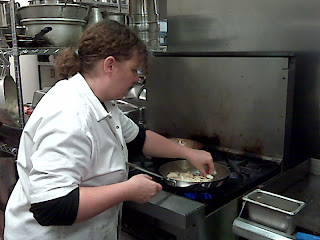Me, I would do the gardening myself. That's part of the point. Initially, I was pretty suspicious of the program that in some crucial ways maintains the disconnect between eaters and their food by letting them off the hook of having to *do* anything to get organically grown, seasonal food; that once again money seemed to "solve" the problem; and the wealthier, as usual, are the ones who could access it. But upon further reflection, I revised my first impression: this may be a viable alternative for some folks who have money but not time to support sustainable agriculture. It's reaching a different demographic, one which would otherwise not be engaged at all in the Great Food Reformation. As such, when I think about it, this is a pretty good program.
On the one hand, Backyard Harvest seems to cater to those wealthy and busy enough to "not have time for that sort of thing" but who for whatever reason -- they read something by Michael Pollan in the NY Times or saw an article in Oprah's magazine that convinced them that organic gardening and eating are the keys to happiness -- want someone to grow good food for them at home. They're missing out on a large part of the joy of the food: getting to know their gardens and the seasons, or at least getting to know their neighbors at the farmers' market or food co-op or CSA pickup.
On the other hand, at least they're supporting organic agriculture and local business. And they're (by proxy) enriching the soil for the future and using their green space for more than just a useless lawn (that they probably rarely even have time to look at or care for anyway). On a personal level, they're eating a wide variety of fresh food and they're not spending their food dollars to support the gargantuan chemical companies or food processors. There is a contribution at the community level as well, I learned during the info session: each customer is encouraged to donate 10% of their garden's yield to a local food pantry. According to Stefan, the lead farmer, every single one of his customers opted to make this donation. So it isn't just the rich hoarding all of the organic brussels sprouts.
One thing that I have come to realize about sustainable agriculture as I've been making my way around the country is that it is by its very nature not a "one size fits all" kind of thing. Different programs are successful -- and necessary -- in different climates, and the communities and regional systems will determine for themselves what works best for them. Generally speaking, communities with a variety of food options -- such as farmers' markets, community gardens, co-ops, CSAs, Market Baskets, Slow Food group meals -- seem to work best. This way, as we collectively work toward more equitable access to seasonal, fresh, regional food, folks can find a way to eat in line with their budget, lifestyle, and schedule. For the Twin Cities, I hope that groups like Backyard Harvest -- just now wrapping up its first year -- continue to be a part of the solution.
Sent from my Verizon Wireless BlackBerry



















